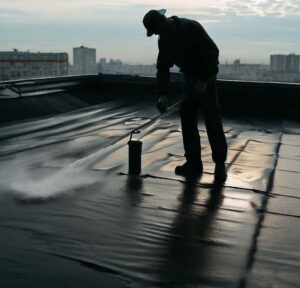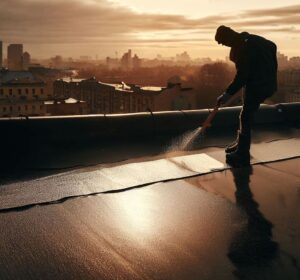Waterproofing, an essential element in the construction and maintenance of buildings, has seen considerable advancement throughout its history. The success of waterproofing measures is felt most when they prevent the costly and structurally compromising effects of water damage. This silent guardian of our structures, however, does not rest on its laurels. The future of waterproofing is defined by ongoing technological progress and emerging trends that seek to make it more efficient, reliable, and eco-friendly. This article unveils this fascinating future landscape of waterproofing and the novel tech-trends shaping it.
Current State of Waterproofing Technologies

Waterproofing, as we know it today, makes use of several traditional technologies that have been refined over time. They’re commonly grouped into three main categories: integral systems, coatings, and membranes.
Integral systems incorporate waterproofing additives, including various groups of chemicals, directly into the construction material, usually concrete. The benefit of this approach is that it avoids the need for subsequent surface treatments and is permanent. It goes a long way in reducing concrete permeability, helping fend off the detrimental effects of water ingress right from the very construction phase. Despite its benefits, disadvantages include extra precautions during the mixing process, cost implications, and its dependency on the quality of concrete used.
Coatings, a common form of waterproofing, involve the application of a layer, often liquid or semi-solid, onto the surface of a given structure. They cure to form a rubbery waterproof membrane that accommodates minor structural movements. These coatings can be asphaltic-based, acrylic-based, or might contain cement. While coatings are a cost-effective method and easy to apply, they’re exposed to external factors like UV rays, abrasive mechanical forces and aggressive chemical environments, which can degrade their performance over time. Hence, they require regular maintenance and periodic renewal.
Membranes act as a physical barrier to the penetration of water and moisture. They can be sheet-based, like bituminous felts, PVC sheets, EPDM rubber, or liquid-applied and are often used for roofing structures or foundations. Membranes, although highly effective, can be susceptible to punctures and mechanical damage. There could also be issues with seams or joints leading to leakage. Application can be more labor-intensive and the quality of installation bears directly on the effectiveness of the membrane.
In light of the increasing demands on the performance of buildings and the growing focus on sustainability, these limitations serve as significant motivating factors for innovation in waterproofing technology. The conservation of resources, reduction in waste, and extension of building lifespan are increasingly influencing principles for developing advanced waterproofing solutions. With the trend moving towards materials and solutions that are more long-lasting, efficient, and environmentally friendly, the future of waterproofing looks set to overcome these traditional limitations.
Emerging Trends in Waterproofing Technology
We are seeing an epoch where the limitations of conventional waterproofing solutions are being eclipsed by innovative technologies. From nanotechnology-based hydrophobic coatings to crystalline methods, the frontier of waterproofing looks exciting and promising.
Hydrophobic coatings make use of the cutting-edge advancements of nanotechnology, manipulating materials at a molecular level to enhance their properties. This enables the creation of nanoparticle enhanced coatings that offer superior protection from water and moisture ingress. When applied, the hydrophobic coatings form a molecular bond that’s virtually impossible to break, creating a seamless, waterproof layer over the substrate. Above all, these coatings are very durable and offer longer useful life compared to conventional coating systems. The use of nanotechnology also contributes to reducing maintenance costs due to their self-cleaning and UV-resistant properties. In other words, not only do they offer enhanced waterproofing, but also a more efficient, cost-effective solution overall.
On a similar front of molecular manipulation, crystalline waterproofing technology offers a solution to the challenges faced by concrete structures. When used, these crystalline materials react with the natural by-products of cement hydration to form needle-like crystals inside the pores and capillaries of concrete. These crystals block pathways for water and waterborne contaminants, effectively waterproofing the concrete from within. One of the most remarkable features is its ability to self-heal. If, over time, new cracks form due to ground movement or settling, any incoming water will trigger the crystalline reaction again, creating new crystals, and the system seals the cracks, thus providing a continuous waterproofing solution.
These novel technologies represent a significant step forward compared to traditional waterproofing methods. By addressing the inherent limitations of traditional solutions, these emerging technologies offer a more advanced, efficient, and sustainable answer to waterproofing needs. It stands witness to the fascinating fusion of construction and breakthrough science, leading the way towards the future of advanced building protection.
The Role of Sustainability in Waterproofing
With climate change and environmental awareness at the forefront of global discourse, sustainability is driving major innovations across numerous sectors, including waterproofing. The thrust towards eco-friendly and green solutions is challenging long-standing practices, leading to the emergence of sustainable waterproofing technologies.
A key trend has been the development and use of biopolymer-based waterproofing materials. These are materials that use plant-based polymers as opposed to petroleum-based ones. The use of plant-based polymers not only reduces our dependence on fossil fuels but also tends to be more environmentally friendly than their synthetic counterparts, as they are biodegradable and derived from renewable resources.
The industry is seeing an increased deployment of recycled materials in waterproofing applications. Whether it’s reclaimed rubber for membranes or recycled glass for waterproof aggregate, so-called “waste” materials find new life in these applications. Each use not only diverts these materials from landfill but also reduces new resource extraction, offering a significant cutback on environmental impact.
What makes these sustainable solutions truly revolutionary is their capacity to deliver comparable if not better, waterproofing functionality. Leveraging advanced scientific research, these eco-friendly waterproofing technologies promise not only reduced environmental footprints but also superior performance. For instance, certain plant-based waterproofing coatings have been reported to have high elasticity and strength, providing excellent adhesion and sealing properties. Similarly, recycled materials used for waterproofing have shown exceptional durability and resistance to weathering, offering longevity than some traditional materials.
As the world continues its march towards sustainable practices, waterproofing techniques are following suit. By incorporating recycled materials and utilizing plant-based innovations, the field of waterproofing is evolving – offering solutions that protect built developments from moisture damage, while minimizing the impact on the environment. In the time to come, these advancements can reasonably be expected to eclipse traditional methods and become the new norm in construction waterproofing.
Future Predictions: Navigation of The Waterproofing Sector

The waterproofing sector is bracing for a future that is significantly shaped by advancements in technology and heightened environmental consciousness. As we explore what this future might look like, several key trends emerge that are expected to guide the evolution of waterproofing methods.
The drive toward sustainability is only expected to intensify. Experts forecast that sustainable coating solutions, both plant-based and recycled, will gain increasing prevalence, continuing to disrupt and displace traditional petroleum-based products. As the quest for minimizing the human ecological footprint continues to mount, construction processes, including waterproofing, will need to adapt and reinvent themselves to align with environmentally friendly norms and expectations.
The Internet of Things (IoT) and data analysis are poised to reshape the waterproofing sector in fascinating ways. Sensors embedded within the architecture may monitor moisture levels in real-time, and provide critical data about water ingress, breaches in the waterproofing layer, and areas requiring maintenance or repair. The use of drone technology for waterproofing inspections is another possibility, offering a safer and more efficient alternative to manual surveys. This integration of advanced technology will not only increase the reliability and effectiveness of waterproofing applications but also expedite fault detection and remediation.
These advancements don’t necessarily translate into higher costs. As these innovative technologies continue to mature and scale, they are expected to become more affordable. The introduction of automated processes and predictive maintenance made possible by IoT and data analytics could yield significant cost savings in the long run. Also, the use of sustainable materials will contribute to the reduction of environmental-related costs, adding another dimension to cost-effectiveness.
These predictions paint an exciting picture of the future of the waterproofing sector. It’s clear that the sector is well underway in its journey to incorporate technologically advanced and environmentally sustainable solutions, showing promise of greater effectiveness and affordability in future waterproofing practices. The future of the waterproofing sector looks both transformative and promising.
The importance of investing in quality waterproofing cannot be overstated. Staying abreast of the latest advancements and embracing technological breakthroughs is imperative. These innovations are redefining not just the waterproofing industry, but construction in general. Their impacts are felt across the cycle of built environments – from design and construction to maintenance and renovation. And for property owners and managers, the promise of cost savings, extended property life, and increased sustainability is surely too good to refuse.